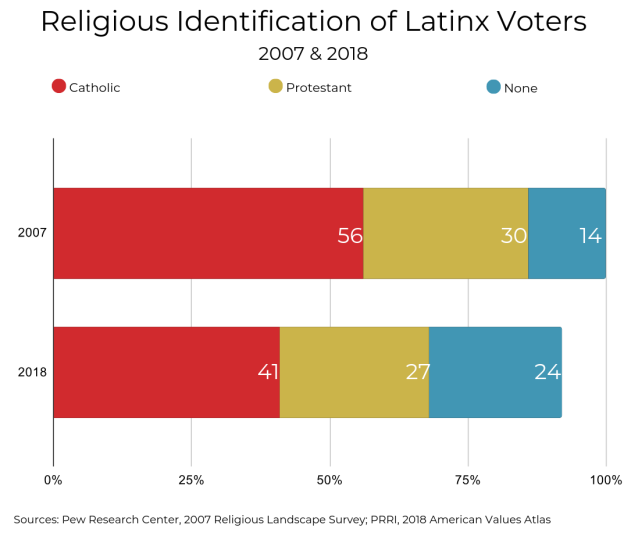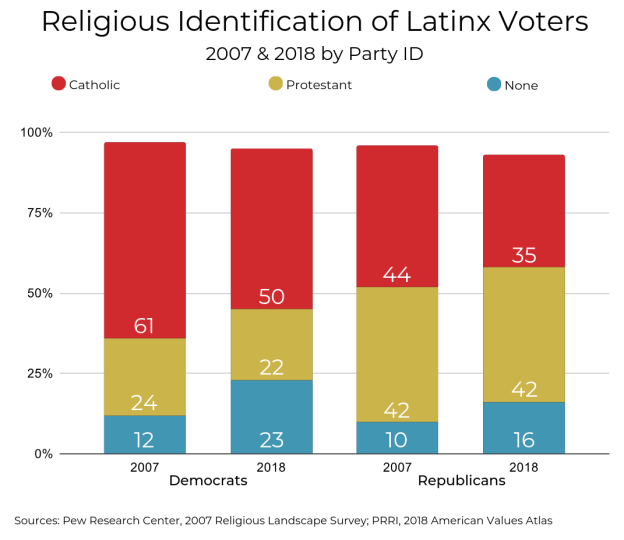By Juhem Navarro-Rivera, Socioanalítica Research
In 2004 the exit polls reported that about 40 percent of Latinxs voted for George W. Bush’s reelection, the highest percentage ever of Latinxs for a Republican candidate. There was talk about Latinxs potentially helping the Republican Party become a more diverse organization and competitive among people of color. As we know now, the Republican Latinx wave never happened.
In the elections since 2004, Latinx Americans have voted for the Democratic candidates Barack Obama and Hillary Clinton by margins approaching or surpassing a three-to-one ratio over their Republican opponents John McCain, Mitt Romney, and Donald Trump. Many consider the Republican Party’s hardening stance on immigration since the end of the Bush-era to have alienated Latinx voters.
In this post, I argue that although immigration and racial politics, in general, may be behind the Latinx decline for the GOP, rising secularism among Latinxs has also contributed to the shrinking of GOP membership in the community. In this post, I will compare Latinx partisanship by religious identity using two large surveys of religious identification: the 2007 Religious Landscape Survey by the Pew Research Center and the 2018 American Values Atlas by PRRI*. These two surveys include large samples of Hispanic respondents and, in addition to religious identification, the surveys include variables about party identification that help us understand how the Latinx political preferences have changed in the last decade.
In 2007, when people still thought that Latinxs were going to become increasingly Republican, the Religious Landscape Survey found that about six in ten (58%) of Latinxs identified as Catholic, roughly a quarter (23%) were Protestant, and 14% were religious nones. Among Latinxs registered voters, however, a higher proportion was Protestant (30%).

By 2018 the religious composition of Latinxs had drastically changed. Catholics comprise a plurality (45%) rather than a majority. One-quarter of Latinxs (25%) identify as Protestant. But the nones (23%) now are approaching the Protestant population in size. Among registered voters, Catholics represent 41%, Protestants 27%, and nones 24%.
This shift in religious identification among Latinx voters has important political consequences. In 2007, 45% of Latinx registered voters identified as Democrats and 21% as Republican. In 2018 partisanship has declined among Latinx registered voters: 39% identify as Democrats and 16% as Republican.
The religious composition of Latinx Democratic voters is similar to the overall distribution. In 2007 61% of Latinx registered voters identified as Catholic, 24% as Protestant, and 12% as nones. In 2018 registered Democrats are 50% Catholic, 22% Protestant, and 23% nones. Republicans are heavily dependent on Latinx Protestants. In 2007 Latinx Republican voters were almost equally divided between Catholics (44%) and Protestants (42%), while just 10% were nones. Today, a plurality of Latinx Republican voters remain Protestant (42%), about one third (35%) are Catholic and just 16% are nones.

Republicans have been affected by two aspects of Latinx religious change. First, Latinx Protestant growth is stagnant. In the years between the 2007 Religious Landscape Survey and the 2018 American Values Atlas, the group has seen a 2 percentage point gain. The cohort has not abandoned the GOP, but with a flatlined growth rate, they are now the dominant Latinxs in the party. Second, the nones are not becoming Republican at the same rate as they are growing in the Latinx electorate.
Although Democrats have also seen a decline in identification among Latinx voters, their outlook is not as grim for a very important reason: ideology. In 2007 35% of Latinx voters identified as conservative and just 22% as liberal. But by 2018 the proportion of conservatives remains virtually the same (34%). Instead, Latinx registered voters who identify as liberal now match the number of conservatives (33%).
Once again, religious identification matters in this trend. Nonreligious Latinx voters account for 34% of liberals today, up from 21% in 2007 and just 16% of conservatives are nones. Protestants still account for around one-third of Latinx conservative voters (34% in 2007 vs. 36% in 2018) but with no growth in that cohort overall, conservatism has also remained stagnant.
In conclusion, Latinx religious identity has changed dramatically in the last decade. More Latinxs are abandoning religion, particularly Catholicism, as has been happening in American society. The shift is not only affecting religious identification, but also Latinx politics. The nones are younger and more politically liberal than Catholics and Protestants. The Republican Party has been reliant on overwhelming support among Latinx Protestants as it tried to make the Latinx vote competitive in elections. Yet, as Latinx nones have grown, Latinx Protestants plateaued, meaning that fewer Latinxs are drawn to the GOP’s conservative message. It is unlikely that the nones will be as receptive as Protestants to GOP messaging in the short term, and while Democrats have not gained as much in terms of identification, the increasing nonreligious-driven liberalism of Latinxs is more in line with the Progressive wing of the party.
*I want to thank Dr. Natalie Jackson, PRRI Research Director, for the 2018 AVA data.
Juhem Navarro-Rivera is the Managing Partner and Director of Political Research at Socioanalítica Research. He is the co-chair of the Latinx Humanist Alliance, serves on the board of directors of the American Humanist Association, and is a Senior Fellow at the Institute for Humanist Studies. You can follow him on Twitter.
**Photo Credits: Latinx atheists during the 2016 Reason Rally in Washington, DC. Courtesy of Josiah Mannion, Edge to Center Photography

[…] proporción de protestantes se mantuvo igual (42%), pero la identificación católica bajó a 35%, lo que podría interpretarse como señales de secularización entre la población Hispano/Latina, con el estancamiento del clúster Latino-Protestante-Republicano.El escenario se hace aun más […]
LikeLike